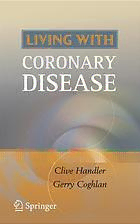
Living with coronary disease PDF
Preview Living with coronary disease
P1:OTE/PGN P2:OTE SVNY305-Handler May13,2007 7:35 Living with Coronary Disease P1:OTE/PGN P2:OTE SVNY305-Handler May13,2007 7:35 Clive Handler Gerry Coghlan Living with Coronary Disease Foreword by Professor Dame Carol Black DBE, FRCP, FMedSci P1:OTE/PGN P2:OTE SVNY305-Handler May13,2007 7:35 CliveHandler,BSc,MD,MRCP, GerryCoghlan,MD,FRCP FACC,FESC ConsultantCardiologist ConsultantCardiologist DepartmentofCardiology TheNationalPulmonary TheRoyalFreeHospital HypertensionUnit London,UK TheRoyalFreeHospital London,UK and HonorarySeniorLecturer DepartmentofMedicine RoyalFreeandUniversity CollegeMedicalSchool London,UK and ConsultantCardiologist HighgateHospital London,UK BritishLibraryCataloguinginPublicationData AcataloguerecordforthisbookisavailablefromtheBritishLibrary LibraryofCongressControlNumber:2006928328 ISBN-10:1-84628-550-X e-ISBN-10:1-84628-551-8 ISBN-13:978-1-84628-550-9 e-ISBN-13:978-1-84628-551-6 ©Springer-VerlagLondonLimited2007 Apartfromanyfairdealingforthepurposesofresearchorprivatestudy,or criticismorreview,aspermittedundertheCopyright,DesignsandPatentsAct 1988,thispublicationmayonlybereproduced,storedortransmitted,inany formorbyanymeans,withthepriorpermissioninwritingofthepublishers,or inthecaseofreprographicreproductioninaccordancewiththetermsoflicences issuedbytheCopyrightLicensingAgency.Enquiriesconcerningreproduction outsidethosetermsshouldbesenttothepublishers. Theuseofregisterednames,trademarks,etc.inthispublicationdoesnotimply, evenintheabsenceofaspecificstatement,thatsuchnamesareexemptfromthe relevantlawsandregulationsandthereforefreeforgeneraluse. Productliability:Thepublishercangivenoguaranteeforinformationaboutdrug dosageandapplicationthereofcontainedinthisbook.Ineveryindividualcase therespectiveusermustcheckitsaccuracybyconsultingotherpharmaceutical literature. 9 8 7 6 5 4 3 2 1 SpringerScience+BusinessMedia springer.com P1:OTE/PGN P2:OTE SVNY305-Handler May13,2007 7:35 Dr. Clive Handler dedicates this book to Caroline, Charlotte, Sophie,andJulius. Dr. Coghlan dedicates this book to Eveleen, Niall, Cathal, andEoin. P1:OTE/PGN P2:OTE SVNY305-Handler May13,2007 7:35 Foreword Patientsareincreasinglyandrightlydemandingaccessibleand readily understandable information which enables them to be full partners in management decisions about their conditions. Organisations such as the British Heart Foundation and the AmericanHeartAssociationhaveproducedmanyhelpfulbook- letsexplainingheartdisease,andformanypatientsthisissuffi- cient.However,forthosewhowantself-helpadviceandamore comprehensiveexplanationofcoronaryarterydisease,itscause, riskfactors,howitisinvestigated,anditsmedicalmanagement, thisbookisanexcellentcompanion. “Living with Coronary Disease” uses terminology in every day use and each chapter can be read in isolation, giving the readerathoroughunderstandingofoneparticularaspectofthe subject.Therelationshipsbetweenexercise,smoking,diet,and heartdisease,arefullyexplained,andthereasonswhynotev- erysmokergetsheartdiseaseelucidated.“LivingwithCoronary Disease”helpsyoucommunicatewithyourdoctormoreeffec- tively; it helps you understand why certain tests are necessary, whattheresultsmean,whentorushtohospitalandwhennot toworrytoomuch. This book meets the needs of anyone interested in under- standing and avoiding coronary disease, and also helps those whohaveorknowsomeonewithheartproblems,toliveasnor- malalifeaspossible,avoidingfutureproblems. ProfessorDameCarolBlackDBE,FRCP,FMedSci Chairman,AcademyofMedicalRoyalColleges,London EmeritusProfessorofRheumatology RoyalFreeHospital,London Foreword vii P1:OTE/PGN P2:OTE SVNY305-Handler May13,2007 7:35 Preface Weareallmorelikelytodiefromaheartattackorastrokethan fromanyotherconditionincludingcancerorinfections.Angina and heart attacks are due to narrowings and blockages in the heartarteriescausingalackofbloodandoxygentotheheart.A strokeisduetolackofbloodandoxygentothebrain.Theseheart andbrainproblemsareduetostiffenedandnarrowedarteries due to deposits of fat called atheroma. This is more likely to occurifapersonhascertainriskfactors.Fatintheheartarteries iscalledcoronaryheartdiseaseanditisthecommonestcauseof deathintheworld. Coronaryheartdiseaseaffectsmenandwomenequallyand starts in childhood. People of all ages, particularly the young, should understand what coronary heart disease is and what can be done to prevent it, or at least, delay it for as long as possible. Althoughwedonotfullyunderstandhowandwhyfatgets depositedinthearteries,weknowthatitismorelikelytohappen aswegetolder,inthosewhosmoke,inthosewhohaveahigh levelofafatcalledcholesterolorsugar(diabetes)intheirblood, inthosewithhighbloodpressure(hypertension),andinthose whoareoverweightanddolittleexercise.Stressisalsobadfor healthandtheheartbutismoredifficulttomeasure.Theseare calledriskfactors.Althoughmanyhavebeenproposed,onlya fewaccountforthemajorityofproblems.Coronaryheartdisease alsorunsinfamiliesalthoughthereisnosinglegenethataccounts forthis. Peoplewithouttheseriskfactorsarelesslikelytogetangina, heart attacks, or strokes. People who have angina or have had a heart attack or a heart operation, improve their chances of a longer, more enjoyable life without further heart problems if they control and correct risk factors. This slows down the progression of fat deposition. The measures that really work are having a low blood level of cholesterol which is helped by eating very little fat – some people may need to take a tablet Preface ix P1:OTE/PGN P2:OTE SVNY305-Handler May13,2007 7:35 to lower the cholesterol – not smoking, making sure that the blood pressure is within the normal range, being slim and fit, andexercisingfrequently,preferablyeveryday.Thesethingsare also very effective in reducing stress and make us feel better, stronger,morealert,andinbetterspirits. A diagnosis of angina is made only if a person has symp- tomsofangina.Thediagnosisisnotmadefromatest.Adiag- nosis of a heart attack is made if a person has symptoms and an abnormal electrical recording of the heart (electrocardio- gram,orECG)andanabnormalbloodtestresult.Thetreatment of angina and heart attacks has changed a lot in the last few years. Thereisnodoubtthatifpatients,theirfamilies,theirdoc- tors,andothercliniciansinvolvedintheircaredotheirbestand worktogetherasateam,theoutcomeforpatientswillimprove. Themorepeopleunderstandaboutthiscommoncondition,the morelikelyitisthattheywillbeabletohelpthemselvesandre- ducetheirriskofgettingitinthefirstplace.Iftheyalreadyhave it,theywillbeabletoimprovetheirchancesoflivingalonger, trouble-freelife.Somethingsthathavebeenproposedhelpalot andothersverylittleornotatall. Both of us spend much of our working lives looking after patientswithcoronaryheartdisease.Inorderforpatientsand their families to receive the best care, they should understand their condition, what the tests and treatments involve – both therisksandthebenefits–andwhichtestsandtreatmentsare the most appropriate for them. Although there are principles oftreatmentwecanapplytoallpatientswithanginaandheart attacks,wetrytotailorthetestsandtreatmentstothepatient becauseeachcaseisdifferent. We have written this book for people who have coronary heartdiseaseaswellasforthosewhowanttopreventit,including youngpeople.Wehavetriedtoavoidmedicaljargonandhave usedsimple,directlanguageinordertoclarifyahighlytechnical andcomplexsubject. Wehopethatyouwillenjoythisbookandthatitwilldis- pelthenaturalfearsoftheconditionandallowyoutobemore in control of your health and your future. It is important to remember that most people with coronary heart disease can and should lead a full, normal, and active life. If you look x Preface P1:OTE/PGN P2:OTE SVNY305-Handler May13,2007 7:35 after your arteries and your heart, your heart will look after you. CliveHandler GerryCoghlan TheRoyalFreeHospital London,UK Preface xi P1:OTE/PGN P2:OTE SVNY305-Handler May13,2007 7:35 Acknowledgements Wewouldliketothankourpatientsandtheirfamilies.Without them,wecouldnotandwouldnothavewrittenthisbook.We wouldalsoliketothankourhospitalcolleaguesandparticularly thenurses,physiologicaltechnicians,andradiographersinour departments,whoareveryimportantmembersoftheteam.We are also grateful to our many colleagues in primary care, who helpuscareforourpatients. Dr.CliveHandlerwouldliketothankhiswife,Caroline,and histhreechildren,Charlotte,Sophie,andJulius,fortheirsupport during the writing of this book. He would also like to thank ProfessorLawrenceCohenMD,specialadvisertotheDean,Yale UniversityMedicalSchool,whohasemphasizedtheimportance ofclearcommunicationwithpatientsandtheirfamilies. TheauthorsarealsogratefultoCharlotteHandler,Depart- mentofEnglish,BristolUniversity,UK,andtoKatieWake,De- partmentofHistory,UniversityofBristol,UK,fortheirhelpwith editingthetext,andtoDeeMacleanfordoingtheillustrations. Dr.GerryCoghlanwouldliketothankhiswife,Eveleen,and histhreesons,Niall,Cathal,andEoin,fortheirsupportduring thewritingofthisbook. Acknowledgements xiii
